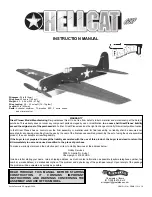
❏
1. Damage to your plane is inevitable during this kind of
combat. However, the simplicity of this model allows it to be
repaired quickly at the flying site. Be sure to put some thick
foam safe CA glue and CA activator in your field box, and
you will be able to be back in flight in a matter of minutes
should repair be necessary.
❏
1. Turn on the transmitter and receiver and center the trims.
❏
2. With the transmitter and receiver still on, check all the
control surfaces to see if they are centered. If the lengths of
the pushrods need to be adjusted to center the control
surfaces, break the glue bond at the ends of the heat-shrink
tubing and make your adjustments. Be sure to re-glue the
ends of the heat-shrink tubing to the pushrod wires when
you are satisfied.
❏
3. Make certain that the control surfaces and the throttle
respond in the correct direction as shown in the diagram. If
any of the controls respond in the wrong direction, use the
servo reversing in the transmitter to reverse the servos
connected to those controls. Be certain the control surfaces
have remained centered.
Use a Great Planes AccuThrow (or a ruler) to accurately
measure and set the control throw of each control surface as
indicated in the chart that follows. If your radio does not have
dual rates, we recommend setting the throws at the low
rate setting.
Note: The throws are measured at the widest part of the
elevator, rudder and ailerons.
IMPORTANT: The FlatOuts Hellcat ARF has been
extensively flown and tested to arrive at the throws at
which it flies best. Flying your model at these throws will
provide you with the greatest chance for successful first
flights. If, after you have become accustomed to the way
the FlatOuts Hellcat ARF flies, you would like to change
the throws to suit your taste, that is fine. However, too
much control throw could make the model difficult to
control, so remember, “more is not always better.”
These are the recommended control surface throws:
High Rate
Low Rate
ELEVATOR:
1-1/4" [32mm] up
3/4" [19mm] up
1-1/4" [32mm] down 3/4" [19mm] down
RUDDER:
1-1/4" [32mm] left
1-1/4" [32mm] left
1-1/4" [32mm] right
1-1/4" [32mm] right
(or max. deflection)
AILERONS:
3/4" [19mm] up
1/2" [13mm] up
3/4" [19mm] down
1/2" [13mm] down
Set the Control Throws
Check the Control Directions
GET THE MODEL READY TO FLY
11


































